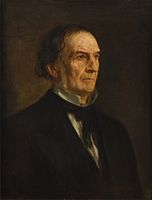
Spencer Compton Cavendish, 8th Duke of Devonshire,, styled Lord Cavendish of Keighley between 1834 and 1858 and Marquess of Hartington between 1858 and 1891, was a British statesman. He has the distinction of having held leading positions in three political parties: leading the Liberal Party, the Liberal Unionist Party and the Conservative Party in either the House of Commons or the House of Lords. After 1886 he increasingly voted with the Conservatives. He declined to become prime minister on three occasions, because the circumstances were never right. Historian and politician Roy Jenkins said he was "too easy-going and too little of a party man." He held some passions, but he rarely displayed them regarding the most controversial issues of the day.
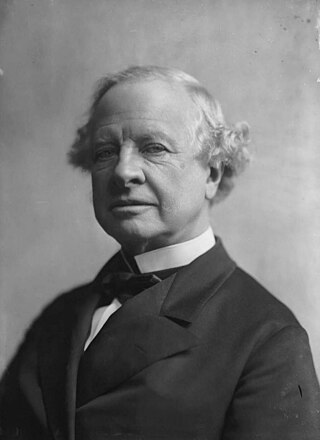
Granville George Leveson-Gower, 2nd Earl Granville,, styled Lord Leveson until 1846, was a British Liberal statesman and diplomat from the Leveson-Gower family. He is best remembered for his service as Secretary of State for Foreign Affairs.

George Frederick Samuel Robinson, 1st Marquess of Ripon,, styled Viscount Goderich from 1833 to 1859 and known as the Earl of Ripon in 1859 and as the Earl de Grey and Ripon from 1859 to 1871, was a British politician and Viceroy and Governor General of India who served in every Liberal cabinet between 1861 and 1908.

Gathorne Gathorne-Hardy, 1st Earl of Cranbrook, was a prominent British statesman and Conservative politician. He held cabinet office in every Conservative government between 1858 and 1892, serving as Home Secretary from 1867 to 1868, Secretary of State for War from 1874 to 1878, Lord President of the Council from 1885 to 1886 and as Chancellor of the Duchy of Lancaster until 1886. In 1878, he was appointed Secretary of State for India, and thereafter ennobled and entered the House of Lords as Viscount Cranbrook.

Michael Edward Hicks Beach, 1st Earl St Aldwyn,, known as Sir Michael Hicks Beach, Bt, from 1854 to 1906 and subsequently as The Viscount St Aldwyn to 1915, was a British Conservative politician. Known as "Black Michael", he notably served as Chancellor of the Exchequer from 1885 to 1886 and again from 1895 to 1902 and also led the Conservative Party in the House of Commons from 1885 to 1886. Due to the length of his service, he was Father of the House from 1901 to 1906, when he took his peerage.

George Joachim Goschen, 1st Viscount Goschen, PC, DL, FBA was a British statesman and businessman best remembered for being "forgotten" by Lord Randolph Churchill. He was initially a Liberal, then a Liberal Unionist before joining the Conservative Party in 1893.

Lord Palmerston, of the Whigs, first formed a government by popular demand in 1855, after the resignation of the Aberdeen Coalition. Initially, the government was a continuation of the previous coalition administration but lost three Peelites within a few weeks. However, other Peelites like The Duke of Argyll and The Viscount Canning remained in office. Palmerston was heavily criticised by Parliament in 1857 over the conduct of the Second Opium War and called a dissolution, but the nation voiced its support in the resulting general election and he returned with a Whig majority.
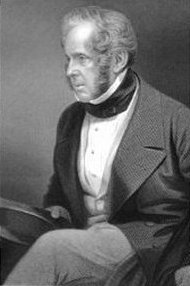
The Liberal government of the United Kingdom of Great Britain and Ireland that began in 1859 and ended in 1866 consisted of two ministries: the second Palmerston ministry and the second Russell ministry.

The Conservative government of the United Kingdom of Great Britain and Ireland that began in 1866 and ended in 1868 was led by Lord Derby in the House of Lords and Benjamin Disraeli in the House of Commons.
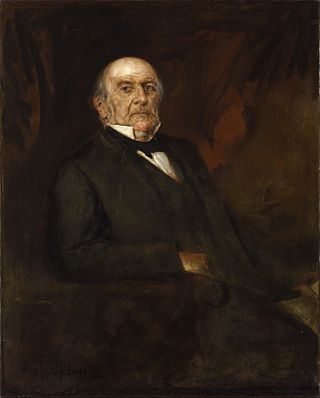
The third Gladstone ministry was one of the shortest-lived ministries in British history. It was led by William Gladstone of the Liberal Party upon his reappointment as Prime Minister of the United Kingdom by Queen Victoria. It lasted five months until July 1886.
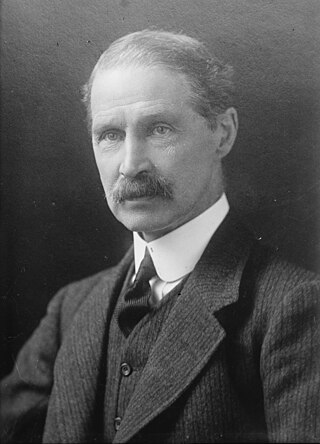
The Conservative Government of the United Kingdom that began in 1922 and ended in 1924 consisted of two ministries: the Law ministry and then the first Baldwin ministry.

Whig Lord John Russell led the government of the United Kingdom of Great Britain and Ireland from 1846 to 1852.

The second Peel ministry was formed by Sir Robert Peel in the United Kingdom of Great Britain and Ireland in 1841.

After campaigning against the foreign policy of the Beaconsfield ministry, William Gladstone led the Liberal Party to victory in the 1880 general election. The nominal leader of the Party, Lord Hartington, resigned in Gladstone's favour and Gladstone was appointed Prime Minister of the United Kingdom for a second time by Queen Victoria. He pursued a policy of parliamentary reform, but his government became wildly unpopular after the death of General Gordon in 1885. Gladstone was held responsible, and resigned, leaving the way free for the Conservatives under Lord Salisbury to form a government.

The Conservative government of the United Kingdom that began in 1957 and ended in 1964 consisted of three ministries: the first Macmillan ministry, second Macmillan ministry, and then the Douglas-Home ministry. They were respectively led by Harold Macmillan and Sir Alec Douglas-Home, who were appointed by Queen Elizabeth II.
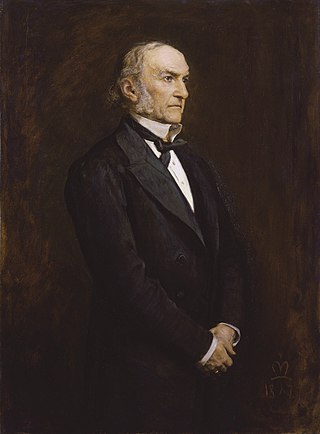
Gladstonian liberalism is a political doctrine named after the British Victorian Prime Minister and leader of the Liberal Party, William Ewart Gladstone. Gladstonian liberalism consisted of limited government expenditure and low taxation whilst making sure government had balanced budgets and the classical liberal stress on self-help and freedom of choice. Gladstonian liberalism also emphasised free trade, little government intervention in the economy and equality of opportunity through institutional reform. It is referred to as laissez-faire or classical liberalism in the United Kingdom and is often compared to Thatcherism.

Edmond George Petty-Fitzmaurice, 1st Baron Fitzmaurice,, styled Lord Edmond FitzMaurice from 1863 to 1906, was a British Liberal politician. He served as Under-Secretary of State for Foreign Affairs from 1883 to 1885 and again from 1905 to 1908, when he entered the cabinet as Chancellor of the Duchy of Lancaster under H. H. Asquith. However, illness forced him to resign the following year.

The Liberal government of the United Kingdom of Great Britain and Ireland that began in 1905 and ended in 1915 consisted of two ministries: the first led by Henry Campbell-Bannerman and the final three by H. H. Asquith.

The Canningites, led by George Canning and then the Viscount Goderich as First Lord of the Treasury, governed the United Kingdom of Great Britain and Ireland from 1827 until 1828.
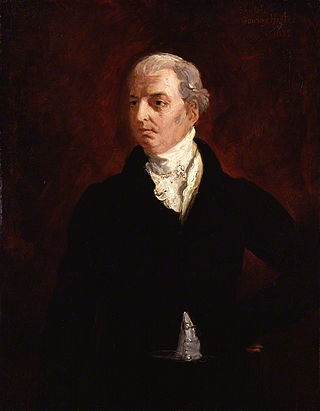
This is a list of members of the government of the United Kingdom in office under the leadership of Lord Liverpool from 1812 to 1827. He was appointed Prime Minister of the United Kingdom by the Prince Regent after the assassination of Spencer Perceval.
